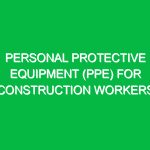Fire Prevention and Protection Strategies on Construction Sites
Fire prevention and protection strategies on construction sites are critical to maintaining health, safety, and environmental (HSE) standards. Fires can cause significant damage, injuries, and even fatalities. Therefore, it is essential to implement effective measures to prevent fires and protect workers and the environment if a fire does occur.
Importance of Fire Prevention and Protection Strategies on Construction Sites
Implementing fire prevention and protection strategies on construction sites is essential for several reasons:
- Health and Safety: Fires can lead to severe injuries or fatalities. Preventing fires helps ensure the safety of workers on-site.
- Environmental Protection: Fires can cause environmental damage by releasing harmful chemicals and pollutants into the air, water, and soil.
- Economic Impact: Fires can lead to significant financial losses due to property damage, project delays, and increased insurance costs.
- Legal Compliance: Adhering to fire prevention and protection regulations is essential to avoid legal penalties and ensure compliance with safety standards.
Hazards Associated with Fire Prevention and Protection on Construction Sites
Construction sites are prone to various hazards that can lead to fires, including:
- Flammable Materials: Construction sites often have flammable materials such as wood, paper, and chemicals.
- Electrical Hazards: Faulty wiring, overloaded circuits, and improper use of electrical equipment can cause electrical fires.
- Hot Work: Activities such as welding, cutting, and grinding generate heat and sparks, which can ignite flammable materials.
- Storage Issues: Improper storage of flammable liquids and gases can increase the risk of fire.
- Smoking: Unauthorized smoking on-site can lead to accidental fires.
Safety Precautions for Fire Prevention on Construction Sites
Implementing safety precautions is crucial to prevent fires on construction sites. Some best practices include:
- Proper Storage: Store flammable materials in designated areas away from ignition sources.
- Electrical Safety: Ensure all electrical installations and equipment are regularly inspected and maintained.
- Hot Work Permits: Implement a hot work permit system to control welding, cutting, and grinding activities.
- Smoking Policies: Enforce strict no-smoking policies on-site and provide designated smoking areas away from flammable materials.
- Fire Extinguishers: Place fire extinguishers in easily accessible locations and ensure workers are trained to use them.
- Housekeeping: Maintain a clean and organized site to reduce the accumulation of flammable debris.
Regulations and Standards Governing Fire Prevention and Protection
Several regulations and standards govern fire prevention and protection on construction sites. These include:
- OSHA Regulations: The Occupational Safety and Health Administration (OSHA) has specific regulations for fire protection in construction, such as 29 CFR 1926.150-1926.155.
- NFPA Standards: The National Fire Protection Association (NFPA) provides guidelines, such as NFPA 241, which outlines fire protection during construction, alteration, and demolition.
- Local Building Codes: Local governments may have additional building codes and regulations that must be followed.
Tools and Equipment for Fire Prevention on Construction Sites
Various tools and equipment are essential for fire prevention and protection on construction sites, including:
- Fire Extinguishers: Different types of fire extinguishers (e.g., water, foam, CO2) for various classes of fires.
- Fire Blankets: Used to smother small fires or wrap around a person if their clothing catches fire.
- Smoke Detectors: Early detection of smoke can help prevent fires from spreading.
- Fire Alarms: Audible alarms to alert workers of a fire emergency.
- Sprinkler Systems: Automatic systems that release water to control or extinguish fires.
Training and Education for Fire Prevention on Construction Sites
Training and education are vital components of fire prevention and protection strategies. Workers should be trained on:
- Fire Safety Procedures: Understanding the fire safety plan, evacuation routes, and emergency procedures.
- Use of Fire Extinguishers: Proper techniques for using fire extinguishers to control small fires.
- Hot Work Safety: Safe practices for conducting hot work activities and the importance of hot work permits.
- Hazard Recognition: Identifying potential fire hazards and taking corrective actions to mitigate risks.
Personal Protective Equipment (PPE) for Fire Prevention
Personal Protective Equipment (PPE) is essential for protecting workers from fire-related hazards. Some PPE includes:
- Flame-Resistant Clothing: Protects workers from heat and flames during hot work activities.
- Safety Goggles: Protects eyes from sparks and hot debris.
- Fire-Resistant Gloves: Protects hands from burns and hot surfaces.
- Respirators: Protects against inhalation of smoke and toxic fumes.
Emergency Preparedness for Fire-Related Incidents
Being prepared for emergencies is crucial for minimizing the impact of fire-related incidents. Key steps include:
- Emergency Plan: Develop a comprehensive emergency plan that includes evacuation routes, assembly points, and emergency contact information.
- Regular Drills: Conduct regular fire drills to ensure workers are familiar with emergency procedures.
- First Aid Kits: Ensure first aid kits are readily available and stocked with necessary supplies.
- Communication: Establish clear communication channels for reporting fires and coordinating emergency responses.
Conclusion
Fire prevention and protection strategies on construction sites are indispensable for maintaining health, safety, and environmental standards. Understanding the hazards, implementing safety precautions, adhering to regulations, and providing proper training are all crucial steps in ensuring a safe construction environment. By prioritizing fire prevention and protection, construction sites can minimize risks, protect lives, and safeguard the environment.


